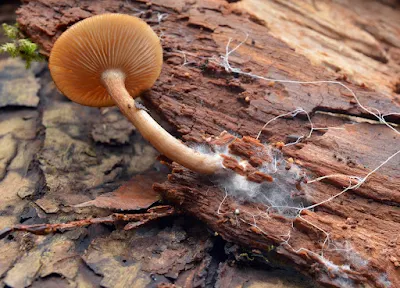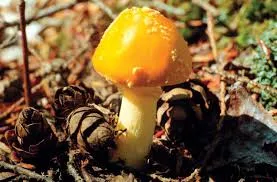Parts Of The Mushroom | Parts Of The Mushroom And Their Functions | Structure Of Mushroom
Parts Of The Mushroom
Organizing the Fungisphere
- This field guide organizes mushrooms from simple and familiar to more difficult and exotic.
- Most foragers are familiar with morels and puffballs, either from their own foraging or as food gifts from friends, so they are listed first.
- There are a few pitfalls when searching for these mushrooms, and I will help you over them. Next up are the pored and toothed mushrooms that produce and disperse spores from pores, spines, or teeth; many are relatively easy to identify and rewarding culinary finds.
- Pores and teeth give way to an intermediate group— the chanterelles, mushrooms possessing the precursor of gills in the form of folded flesh, gill-like, but not gills.
- Here are some of the best-tasting fungi available on the planet. Not to be upstaged are the gilled mushrooms.
- This vast group with so many look-alikes requires rigorous identification and cautious respect.
- They are potentially the most dangerous mushrooms and some of the most beneficial.
- The final two chapters cover commercially available medicinal mushrooms and poisonous mushrooms.
- There are two main parts to a mushroom fungus; An above-ground fruiting body or sporophore and the underground mycelium.
Mycelium
- Mycelium forms the underground part of the fungus that we seldom see.
- It’s a vast, complex network of cells that form thin fibers, like plant roots, and spread under the forest floor in search of nutrients.
- When a mushroom spore lands in a spot with ideal growing conditions, it germinates. Producing thread-like filaments called hyphae that grow, interconnect and form mycelium.
- Extensive networks of mycelium spread over large distances underground and connect fungi to each other.
- Mushrooms don’t have chlorophyll like plants for food production. Instead, the mycelium grows by absorbing nutrients from dead and decaying organic matter.
- Mycelium lives for many years and may remain dormant for several seasons until conditions are perfect for fruiting.
 |
| Mycelium |
Fruiting Body
- The umbrella-shaped body of a mushroom that we recognize is the fruit of a much larger underground fungus.
- They’re called fruiting bodies or sporophores and are the fleshy, sometimes edible, part of the fungus.
- The fruiting body usually grows above the ground or on the surface of a host. Its purpose is to produce and distribute spores so the fungus can reproduce.
 |
| Fruiting Body |
Cap
- The cap of the mushroom is the topmost part and gives the fungi its umbrella-like shape. It can be flat, conical or spherical and have a wide range of textures and colors.
- The caps’ color and texture don’t only vary by species. They also change depending on the stage of development of the mushroom.
- The shape of the cap also changes throughout the development of the mushroom.
- The cap contains the spore-producing surface of the mushroom, made up of gills, pores or teeth.
- The function of the cap is to protect the spore-producing surface. It does this in the same way that an umbrella would protect you from rain or the heat of the sun.
 |
| Cap Of Mushroom |
Gills
- The gills are thin, paper-like structures layered side by side that often hang from the underside of the cap.
- Gills come in various colors and have distinct features, making them useful for species identification.
- The shape of the individual gills, their color and how far apart they are from each other all play a role.
- How and where they attach to the stem is also important for mushroom identification.
- Not all mushrooms have gills. Some, like porcinis, have pores. These are tiny, tightly packed tubes that resemble a sponge.
- Others, like lion’s mane, have teeth or needles instead of gills.
- The function of the gills, called lamellae, is to produce and disperse billions of spores.
 |
| Gills Of Mushroom |
Spores
- Mushroom spores are microscopic, unicellular reproductive cells produced in the gills.
- Most spores are shades of white, brown, pink or black, but there are also some mushrooms with orange, green and yellow spores.
- Some scientists use the color, size and shape of spores to identify fungi.
- A mushroom spore is like a seed in that it contains all the genetic material required to grow new mushrooms.
- At the end of the mushroom growth cycle, mushrooms release their spores. Wind, water, animals or humans then disperse them.
- The spores need to land in a warm, moist, shaded area to germinate.
 |
| Spores Of Mushroom |
Ring
- A ring of tissue is sometimes found on a mushroom stem. It’s the remaining part of a partial veil.
- A partial veil is a thin piece of tissue that provides an extra layer of protection for the gills when the mushroom is young.
- As the mushroom matures and the cap grows, it ruptures the partial veil exposing the gills. Sometimes the remnants of the veil form a ring of tissue around the stem.
- Rings vary considerably and may be thick and prominent or thin and cobweb-like.
- People use the ring type, position and shape for the identification and classification of mushrooms.
| Ring Of The Mushroom |
Stem
- The stem or stipe supports the cap and elevates it above the ground.
- The function of a stem is to assist with the dispersal of the spores. In the wild, many mushrooms use the wind or animals to scatter their spores.
- Thus, the cap and gills need to be high enough from the ground for the mushroom to effectively release its spores into the wind or onto passing animals.
- The size, shape and texture of the stem play a role in identifying mushrooms.
- Some mushrooms have no stems at all. While others, like oyster mushrooms, have gills that extend down the sides of the stem.
 |
| Stem Of Mushroom |
Volva
- The volva or universal veil is a layer of tissue that protects the immature mushrooms of some species as they grow out of the ground.
- As the mushroom matures, it breaks through the universal veil, leaving the bottom part of the veil at the base of the stalk.
- The remnants create a cup-like shape at the stem’s base. The volva is very important when identifying mushrooms in the wild.
- A volva is a significant feature of mushrooms in the Amanitaceae family, many of which are very poisonous.
 |
| Volva Of Mushroom |
Hyphae
- The hyphae are the microscopic,thread-like filaments or tubes that interconnect and grow to form the web-like mycelium or body of a fungus.
- The function of the hyphae is to absorb nutrients from the environment and transport them to other parts of the fungus.
 |
| Hyphae Of Mushroom |
Mushroom consultants in India.
Top mushroom company.
Biobritte Agro Is A Reishi Mushroom Exporter Company.
For more info - https://www.biobritte.co.in/collections/all
Contact on a phone or WhatsApp 9923806933 or 7709709816.
Biobritte Agro Solutions Private Limited.
MycoNutra® Mushroom product distributorship.
Tags - parts of the mushroom, parts of the mushroom and their functions, structure of mushroom, mushroom gills, mushroom mycellium, mushroom spores, mushroom fruiting body, mushroom hyphea, mushroom volva, mushroom stem, mushroom ring, mushroom gills, mushroom cap, edible part of mushroom, mushroom parts, sensitive part of mushroom, parts of mushroom plant, parts of mushroom to eat, part of mushroom spores, parts of mushroom gills, parts of mushroom volva, part of mushroom volva, part of mushroom stem, part of mushroom gills, part of mushroom hyphea, part of mushroom spores

Comments
Post a Comment